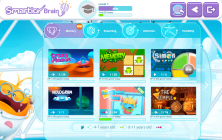
In a recent post on our blog, we spoke about the importance of working memory in learning mathematics. Memory skills, and exercising memory skills, are critical to any mathematical task such as memorizing multiplication tables or remembering the order of operations and geometric formulas.
There are different types of memory, but Smartick Brain games primarily focus on exercising working memory and short term visual memory. Both of which are fundamental to the development of good mathematical skills (Li & Geary, 2013).
Now we are going to look at some games from Smartick’s Virtual World that can be played to improve memory skills and facilitate the learning of mathematics in children.
Crazy Planet
This activity is based on the n-back principal, which is highly recognized in scientific literature for its cognitive training benefits (Klingberg, 2010). We are on a distant planet and different aliens pop out of their craters, very quickly, one after another. Each time an alien appears the child needs to say whether or not it is the same as the one before. Sometimes it is much easier because the aliens being compared are very different, and other times it’s more difficult because the aliens are very similar. The speed of the game tests working memory and attention in children. Each time the child does not respond correctly they lose one of the three lives they have available.
Memory
It is a traditional game to exercise short term memory and working memory combined with aspects of visuospatial training. In this game, the children must look for matching pairs of cards. In more advanced levels we find variations of the game where, for example, they have to find pairs of cards that don’t have the same image, but rather related images – like a bed and a mattress.
Simon
Simon is a game that is mainly used in exercising memory, mainly short term, and the process of updating working memory. It includes audible, sensory and rhythmic aspects, making it a very powerful game. There are four different colored keys which light up to form a sequence. The child has to memorize the sequence and recreate it. Each key has a different electronic sound to help the player remember the light-up sequence. Each level adds a new key to the sequence and the game becomes more difficult. The game ends when the player makes a mistake and incorrectly recreates the sequence.
The Temple
This is a game to train visual memory skills. We are in a jungle, in front of a majestic temple. The children will need all of their memory skills in order to determine, among a set of keys, which is the magic key to open the door to the temple. Only one is the authentic key! If they choose correctly, it will open the door.
Hologram
Hologram is a typical game to train cognitive memory. Initially, there is a 3×3 matrix and some of the squares are lit up white for a short time. The child needs to remember which squares were lit and click on the empty squares to form the memorized sequence. As the child progresses through the levels, the matrix becomes larger and the task more complex.
Remember Me 2
Remember Me 2 will be available on Smartick Brain next week! This game helps children to develop their visual skills. An avatar appears on the screen for seven seconds. The children must observe and remember the details to the best of their ability because on the next screen the same avatar will appear, but will be missing something. They need to find what is missing and make the avatar look like it did before.
What are you waiting for? Try our games for exercising memory for free when you register with Smartick.
References:
- Li, Y., & Geary, D. C. (2013). Developmental gains in visuospatial memory predict gains in mathematics achievement. PloS one, 8(7), e70160.
- Klingberg, T. (2010). Training and plasticity of working memory. Trends in cognitive sciences, 14(7), 317-324.
Learn More:
- Educational Games on SmartickBrain, Essential for Learning
- Exploring Cognitive Training Using Memory Games
- How Smartick Virtual World Games Might Help Your Child’s Math Achievement
- Cognitive Flexibility Games with SmartickBrain
- Lost Objects: The New SmartickBrain Game to Train Attention
- Mistakes: An Opportunity to Learn - 05/07/2020
- The Importance of Positive Reinforcement in Education - 04/02/2020
- Is It True That Boys Are Better at Math Than Girls? - 03/05/2020







